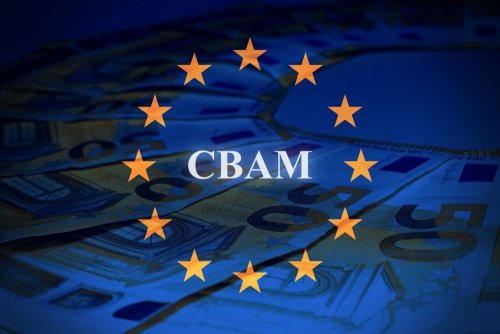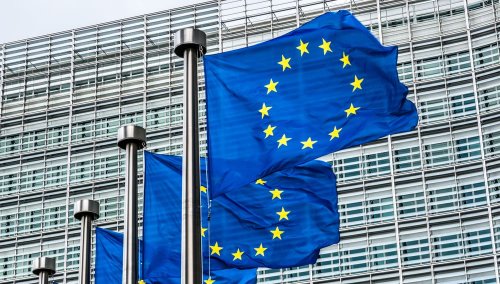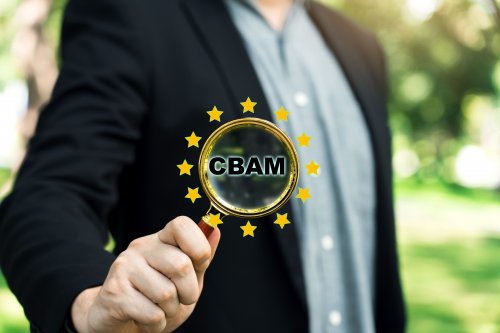The Ministry of Environmental Protection and Natural Resources plans to develop an Emissions Trading System (ETS) in 2024. In particular, it is planned to adopt a framework law implementing European standards for reducing carbon emissions. However, EcoPolitic talked to Olha Boyko, coordinator of the EBA's Industrial Ecology and Sustainable Development Committee, about whether Ukraine is really ready to launch the ETS, both legally and in practice.
- How do you assess Ukraine's preparation for the implementation of the emissions trading system? Is the legal basis ready?
I usually try to give my own assessment, but in this case I will agree with the European Commission's vision published on November 8, 2023 in its report on Ukraine as part of the enlargement package. In particular, the compliance of Ukrainian legislation with EU law in terms of environmental and climate protection was assessed as containing a "certain level of preparation," i.e. a D. This is the result of work in 2022-2023. At the same time, the European Commission points out the need for Ukraine to urgently step up preparations for the launch of the greenhouse gas emissions trading system (ETS), as well as to strengthen its administrative capacity in terms of human and financial resources.
Although, to its credit, in 2023 the Ministry of Ecology updated some regulations on monitoring, reporting and verification of greenhouse gas emissions (MRV), taking into account business proposals. The MRV is the basis for the further launch of the ETS.
- Minister of Environmental Protection and Natural Resources Ruslan Strelets said that in Ukraine ETS plan to launch in 2025 these in test mode. Do you think this is real?
Indeed, for six months we have been observing the obsessive idea of the head of the Ministry of Environment to launch ETS in 2025. More precisely, plans are as follows: adopt the law on the emissions trading system in 2024, launch the ETS in 2025 in pilot mode, fully launch the STV in 2026.
But do we have all the necessary elements for this?
Necessary prerequisites for the launch of ETS are the presence of a real working one in Ukraine system of monitoring, reporting and verification of greenhouse emissions (MRV) , as well as approval of the updated Nationally Determined Contribution to the Paris Agreement (NDC-3).
The MRV system is necessary to accurately determine the amount of greenhouse gas emissions that enterprises should cover with purchased allowances. It is most optimal to launch the ETS at least three years after the MRV system starts functioning, when there is sufficient verified data on emissions volumes and dynamics. As of the beginning of 2024, due to the extension of martial law, companies still have the right to postpone the submission of emissions reports under the MRV, which means that the probability of starting even the pilot phase is already shifting to 2027.
Roughly the same applies to the MRV-3, which is required to set the emissions limit in the ETS. The document should serve as a benchmark for the volume of supply on the market and will have a direct impact on the price and competitiveness of the economy. Therefore, it is advisable to develop the NER-3 in a bottom-up manner, from companies to the national level. That is, first, collect information from companies on their emissions and plans to reduce them, and then, based on this data, set a goal to achieve certain greenhouse gas emissions at the state level. This will be possible after the end of hostilities.
It is also necessary to find answers to other key questions related to the ETS, such as which industries and enterprises will become market participants, what will be the upper threshold for emissions, and what will be the mechanism for distributing free allowances, etc. And perhaps most importantly, which institution will be responsible for administering the ETS. All of this requires careful planning and preliminary discussion with all stakeholders, primarily with ETS participants.
Moreover, so far, the approved Action Plan of the Ministry of Environment for the preparation of draft regulatory acts for 2024, which consists of 26 points mainly in the areas of subsoil use and forest resources, does not contain any intentions to work towards climate change. We hope this is temporary.
- What consequences should Ukrainian exporters to the EU expect if Ukraine does not have time to launch its own ETS in time?
Finally, I would like to break the false link between the implementation of the ETS and the CBAM. Talks about the need to quickly introduce an ETS by 2026 (when the second phase of the CBAM begins with the introduction of an actual fee for CO2 emissions) as a panacea for avoiding the CBAM fee have been going on for more than a year. But do they have a reasonable basis?
Today, there are at least 10 national ETSs in the world, 8 of which are in countries outside the EU: China, Kazakhstan, Mexico, Montenegro, New Zealand, Republic of Korea, Switzerland, and the United Kingdom. However, only Switzerland is included in the list of countries exempted from the CBAM (Annex III of the Regulation).
By the way, it is worth taking a closer look at Switzerland's path. The Swiss ETS started in 2008 with a five-year voluntary phase. Since 2013, participation has been mandatory for large energy-intensive enterprises and voluntary for medium-sized ones, all of which are exempt from paying the CO2 tax. The Swiss ETS covers electricity generation, industrial enterprises (mainly cement, chemical, pharmaceutical, pulp, oil refining and metallurgical sectors), as well as aviation. In total, 98 stationary installations and 148 aircraft operators participate in the Swiss ETS, covering about 10.6% of the country's total greenhouse gas emissions.
In 2019, the EU and Switzerland signed an agreement on linking (merging) the Swiss ETS with the EU ETS. Negotiations on this agreement lasted 10 years, and it is currently the only such agreement.
Another example is the UK, which has been a member of the EU ETS since 2005. After leaving the EU, in 2021, the country introduced its own ETS, which in some respects is more tailored to national economic needs and support for industrial competitiveness. However, this did not help it, as well as China and Mexico, which launched their ETSs in the same year, to obtain an exemption from the CBAM.
That is why an ETS in Ukraine should not be viewed solely as a tool for exemption from the CBAM, but should be designed to gradually adapt the country's economy and participants – both the government and emitters – to the EU ETS. There is no need to rush this process, as it will only do harm.
To reduce the impact of the ETS on the Ukrainian economy, it would be more effective to develop a similar instrument, the so-called "Ukrainian ETS," as the UK, the Republic of Korea, and others are already planning to do.
- Does the government support dialogue with business in this matter?
The first in-depth work on creating an ETS concept in Ukraine with the involvement of stakeholders took place in 2021-2023 as part of the project "Support to the Establishment of a Greenhouse Gas Emissions Trading Scheme (ETS) in Ukraine" initiated by the German Society for International Cooperation (GIZ) together with the international consulting company "adelphi". These were webinars aimed at familiarizing stakeholders with the basic elements of the ETS and involving them in the development and design of the future ETS in Ukraine.
However, due to the full-scale invasion, all previous developments and recommendations of the project have lost their relevance, which has significantly pushed Ukraine back in this direction.
Recognizing the complexity of the situation, the EBA Industrial Ecology Committee prepared a concept for the introduction of an emissions trading scheme in Ukraine in 2023. The first expert discussion of the study results has already been held, and a position paper has been sent to the authorized bodies, including the Ministry of Environment.
So far, we have not received a response, but we are looking forward to it and are ready to cooperate in this area.
- In your opinion, currently creating your own ETS is a potentially better climate tool than an eco-tax?
The ETS and the CO2 eco-tax are carbon pricing instruments aimed at reducing greenhouse gas emissions. At the same time, the world's largest economies are choosing the ETS as a carbon pricing tool. According to the International Carbon Action Partnership, one third of the world's population lives in countries that have implemented ETSs to some extent. The ETS covers 17% of global CO2 emissions and this share will grow.
At the same time, the ETS instrument seems to be more flexible and has a number of advantages.
First, the price of CO2 emissions remains fixed under the eco-tax, while under the ETS it is formed by the market itself, which allows supporting climate ambitions by setting appropriate CO2 emission limits, while under the existing carbon taxation it is impossible to limit emissions directly. It is also an opportunity for companies that have reduced emissions and have not used their allowances to sell them and receive additional financial revenues and incentives to continue decarbonization.
Second, carbon taxation implies that companies pay the price for CO2 emissions in full. At the same time, ETSs are usually designed in such a way that companies pay only a part of the CO2 price. Thus, the government distributes a certain number of allowances free of charge, while the rest are purchased by enterprises either at auctions conducted by the government or on the secondary market from other participants.
Thirdly, the ETS provides for the possibility of targeted use of funds from emission fees, unlike the environmental tax. In Ukraine, the funds from this tax have traditionally gone to the general fund of the state budget (without earmarking) and have been considered a source of state revenue. This led to the loss of the linkage of the carbon fee to stimulating their reduction, as lower emissions lead to lower state budget revenues. In this case, the state was not interested in reducing greenhouse gas emissions, and if these emissions decrease, the state may initiate an increase in carbon tax rates to preserve the source of budget revenues.
Starting from January 1, 2024, 100% of the revenues from the CO2 eco-tax will be directed to the State Fund for Decarbonization and Energy Efficient Transformation, a new line in the State Budget. The funds are to be used to implement measures and state targeted programs in the field of energy efficiency, increase the use of renewable energy sources and alternative fuels, reduce carbon emissions, as well as to compensate, reimburse, and reduce the cost of obligations of individuals and legal entities under loan and leasing agreements in these areas. Traditionally, however, this ambitious plan cannot be implemented until the Cabinet of Ministers approves the procedure for using the Fund's resources.
Fourth, Ukraine's key trading partners are implementing their own ETSs. In addition to the EU, China and some US states have ETSs in place. Turkey is also preparing to launch an ETS. The launch of Ukraine's ETS will allow for future negotiations on possible mutual recognition of other countries' ETSs and special conditions for economic cooperation, which is critical given that the introduction of cross-border carbon adjustment mechanisms (CBAMs) will become widespread.
- In terms of carbon markets, Ukraine lags behind the EU by at least 18 years. Can we make up for lost time and what should be done first and foremost?
If we do everything right, the total period of transition to the European emissions trading market will be 12 years.
Currently, we can talk about three stages of the ETS launch in Ukraine.
1) 2026-2027 – the stage of elaborating the procedures necessary for the scheme's operation; in the EU, a similar stage lasted three years. Based on this, it can be fully tested and held in demo mode, without affecting business costs, as it was in the EU and is happening now in other countries.
2) 2028-2031 – the targeting stage, i.e. setting an economically justified price per ton of emissions, which will take into account the dynamics of the Ukrainian economy and the permissible level of carbon payments for enterprises. In this context, one of the possible pricing tools could be the principle of "economically reasonable price", namely copying the level of tax burden of carbon payments to GDP that occurred during the 3rd and 4th phases of the EU ETS, i.e. from 0.02% to 0.2%.
3) 2032-2037 – the stage of alignment of prices per ton of emissions with the European level. This stage should be the longest to avoid adverse effects on the economy of a sharp rise in emission allowance prices. After that, full integration with the EU emissions trading scheme is expected.
- Should Ukraine follow the EU ETS as a role model or should it go its own way?
The main goal of implementing the ETS in Ukraine is to adapt the domestic economy to integration into the European economic area. Adaptation should ensure that Ukraine's economy remains competitive in the process of green energy transition and accession to the EU ETS.
This means gaining experience in the ETS by enterprises, preparing the necessary management institutions, creating decarbonization financing instruments, reducing the carbon intensity of industries to a level that will allow them to be competitive in the EU market under the EU ETS, gradually moving to the same level of greenhouse gas emission prices as in the EU ETS, etc.
Therefore, it is advisable to design the parameters of the Ukrainian ETS system as close as possible to the European model, but taking into account the state of the Ukrainian economy affected by the war, the degree of technical development of Ukrainian enterprises, and the specifics of the public administration system and interaction between the state and business.





